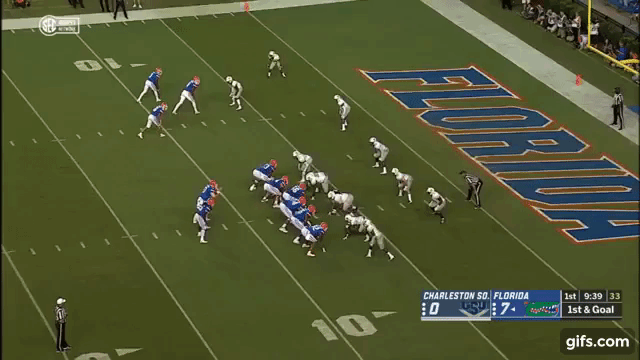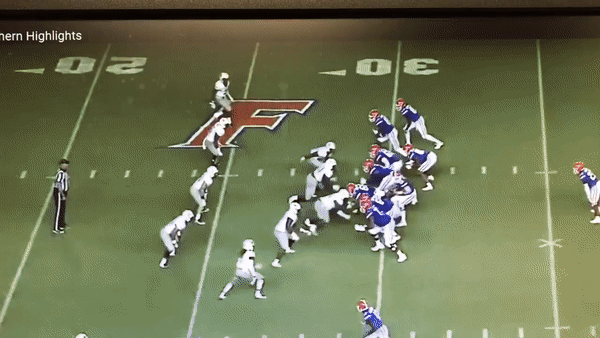
Florida football: Gators must begin to solve running game struggles against Colorado State
Florida’s 31-game winning streak over Kentucky is history, and all that’s left is to take inventory of what went wrong and begin the process of fixing what can be corrected.
One of most problematic developments for Florida early in the 2018 season is the underperforming run game, highlighted by the poor play of Florida’s offensive line.
Last week’s film study noted that even against Charleston Southern’s undersized FCS defensive line, Florida struggled to get much of a push up front, forcing its talented group of running backs to rely heavily on picking up yards after contact, at least when it was Florida’s ones vs. Charleston Southern’s ones. Dameon Pierce certainly did some damage late, but most of that came when Mark Tucker had emptied out the Buccaneer bench and Florida’s twos were playing FCS twos.
Florida’s offensive line returned 112 starts collectively and was thought to be a potential strength entering the fall. It simply hasn’t panned out that way, and even left tackle Martez Ivey, a consensus preseason All-SEC selection, has struggled to get much leverage in the running game, as this clip from the Charleston Southern game demonstrates.

These are problems that continued in the first half against Kentucky.
The Gators had outstanding success against the Wildcats on the ground a year ago, and they clearly intended to establish the run at home in the first half Saturday night.
Unfortunately for Florida, without much of a push up front, the run game was largely ineffective in the first half, collecting only 51 yards on 17 attempts for a paltry average of 3.0 per attempt.
For this reason, the idea that Florida “abandoned” the run game in the second half is a bit misconceived. Instead, Florida set out to establish the run and found itself moving the ball better through the air (8.5 yards an attempt in the first half).
Once Florida fell behind, with the run game largely ineffective, Dan Mullen and the coaches felt, with some justice, they needed to place more on Feleipe Franks’ shoulders, and Franks simply wasn’t as effective outside of the “game manager” role he performed well in during the opening half.
Florida ran the ball only 12 times in the second half, and of those, six came on Florida’s impressive but too-little, too-late 99-yard touchdown drive in the fourth quarter.
All told, Florida was outrushed on the evening 303 yards to 128, and Kentucky’s gargantuan average of nearly 8 yards a carry dwarfed Florida’s very pedestrian 4.4 yards an attempt.
Florida’s run game production must improve, for the obvious reasons that Franks simply isn’t ready to be the guy who puts the offense on his shoulders and that the Gators are far too talented in the backfield to be the pass-first offense they were in the second half.
Mullen’s scheme is designed to do two things, primarily.
The first is to be a run-dominant offense, as we wrote this summer.
Mullen wants to utilize a host of zone and power run concepts to control the clock, win field position and establish the play-action passing game. (See the video below for a lengthier explanation by the head coach himself).
https://www.youtube.com/watch?v=EOyNtHL79ag
The second is to exploit numerical advantages, especially pre-snap and in the running game.
For example, if an opponent shows five in the box and Florida has a slot receiver, tight end and running back, this is a favorable matchup for a run.
On the contrary, if an opponent puts seven or eight inside, Florida’s numbers on the boundary are going to be better. As a result, a pass is more likely. The overarching concept of the offense is to get the football to the spots where the defense has the fewest number of helmets to pursue the football.
Herein lies the rub.
It is much harder to exploit numerical advantages when you can’t get any leverage up front. What’s worse, Kentucky is at best an average SEC defensive line, and the Wildcats were still able to negate Florida’s frequent numerical advantages.
Florida will face at least two and arguably three defensive fronts in the next month more physical than Kentucky’s when they travel to Tennessee (Sept. 22) and Mississippi State (Sept. 29) and host LSU (Oct. 6). If Florida can’t keep the interior of opposing defensive lines out of their backfield, they will struggle mightily in each of these football games.
Can it be fixed?
Some of it is cultural, according to Mullen.
Asked Saturday night what he can do to improve Florida’s physicality at the line of scrimmage, Mullen offered this reply.
“You really can do a lot. It starts even just how we practice with the guys. We’re not going to change how we practice. They just have to learn how to practice the right way. I watched some of the stuff — when you’ve got scout periods, you go to the other team’s looks, they kind of treated that as walkthroughs, and it’s not. You’ve got to thud. You’ve got to wrap up. You’ve got to drive back. Scout teams have got to perform better and be a little bit more physical. It’s a mind-set of how you practice and how you treat every day.”
That’s on the Gators’ leadership and the players. Who do you want to be? How do you want to be remembered?
Some of it is about personnel.
Brett Heggie missed a great deal of camp recovering from a leg injury suffered late last season. It’s understandable why Mullen and offensive line coach John Hevesy want to move him along slowly.
Then again, Heggie also graded out as Florida’s best offensive lineman a year ago, and Florida’s largest problems Saturday night were at the guard spot, particularly when they tried to pull anyone. Heggie can correct a host of those problems, but he needs to get out of the training room and onto the football field by the time Florida travels to Knoxville in two weeks.
Florida also needs to sort out its running back rotations
The common perception is that Jordan Scarlett is Florida’s best running back.
The statistic “success rate” — which measures exactly what it sounds like, the “success” of any given play compared to all plays run — suggests otherwise early in the season.
An “average” college football “success rate” in 2017 was around 42 percent.
Scarlett’s success rate Saturday night was a woeful 28.6 percent. It was much better against Charleston Southern, at 50 percent, but even that number was the second lowest of all Florida running backs.
Could some of this be because defenses key on him, especially on non-obvious passing downs? I suppose.
More likely, it has to do with his tendency to dance a bit or run sideways with low leg turnover instead of generating high leg turnover and decisively making one cut and hitting the first gap, which you see Lamical Perine do here.

Perine’s early season success rates have been well above the national average: at 100 percent vs. Charleston Southern and 50 percent against Kentucky.
Given Perine’s advantages as a blocker, perhaps Florida should reconsider its running back triage as they move into the Colorado State game. Alternatively, maybe they should simply scrap the idea of dividing carries evenly and allow a back like Scarlett, whose production has always improved as he finds the rhythm of the game, to be the primary ballcarrier.
Either way, the current format isn’t working, and the running game is a problem Florida must begin fixing this week against Colorado State.
Neil Blackmon covers Florida football and the SEC for SaturdayDownSouth.com. An attorney, he is also a member of the Football and Basketball Writers Associations of America. He also coaches basketball.







